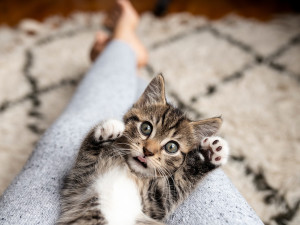7 Feline Myths, Busted
No, cats don’t always land on their feet.

share article
Cats are featured prominently in mythologyopens in a new tab, and that’s cool, but there are a lot of prevailing misconceptions about cats, and that is definitely not so cool. Debunking these myths gives us a greater understanding of the true nature of cats, and therefore allows us to build closer relationships with the cats in our lives. Below, some of the most common feline stereotypes and superstitions.
1. Myth: Cats can’t be trained.
It’s curious that when many people think of training their pets, they only think of dogs. All the other animals can be trained, too — goldfish, rats, geckos, anoles, lovebirds, hamsters, hermit crabs, and of course, cats. With the use of positive training techniques, treatsopens in a new tab, toysopens in a new tab, patience and love, cats can be trained to high-5, come when called, play fetch, present their paws for nail trimsopens in a new tab, enter a cat carrier,opens in a new tab hop up on a table, and so much more.
2. Myth: Cats always land on their feet.
Cats are agile, and frequently capable of turning in mid-air to land in a manner that any Olympic gymnast would envy. However, they don’t magically land safely. They need enough time to make those maneuvers and if they fall from too low a height, they can and do land on their backs or sides, which can cause injury. Additionally, if they fall or jump from too great a height, even landing on their feet can’t protect them from injuries to their legs, back, or other body parts.
3. Myth: Cats are nocturnal and can see in total darkness.
Really two myths in one, the idea that cats are creatures of the night isn’t entirely correct. Cats are crepuscular, meaning that they are most active at dawn and dusk. They can be awake at any time of day or night, and just because they are walking all over you as you try to sleep doesn’t mean they are nocturnal. Cats can see in very low light because they have a lot of light-sensitive receptors in their eyes, and because they can open their pupils really wide to let in more light. However, they can’t see when there is no light at all.
4. Myth: Cats are low-maintenance pets.
Perhaps no myth has done more damage to the quality of life for cats. Cats need a lot of attention and care. Just because they may not be super pushy or demanding if they don’t receive it doesn’t mean their well-being isn’t being compromised. Possibly because they don’t require daily walks, a myth of low maintenance has developed. However, caring for a cat requires lots of time spent playing with, groomingopens in a new tab, training and petting them, all of which help develop a good bond. Daily maintenance of the litter box, regular feeding, and changing out their water supply also require time.
5. Myth: Cats hate getting wet.
Not all cats object to having a swim, though it is true that many cats are fearful of being submerged in water. That may be a result of bad experiences with water early on, a natural inclination to stay true to their desert-dwelling ancestors, or perhaps wariness because they lack experience being in water. There are plenty of cats of every type who enjoy being in wateropens in a new tab and seek it out. An affinity for water is most common in certain breeds such as Turkish Vans, which have been nicknamed “swimming cats” and Bengal cats, who are famous for their love of H2O, and happily take to the water.
6. Myth: Cats shouldn’t be around pregnant women.
The myth that cats are a danger to pregnant women has caused many a cat to be ejected from the home when someone is newly expecting and caused many families to grieve the cat they miss. Nobody should have to say goodbye to a cat because of pregnancy. The kernel of truth behind this myth is that cat feces can contain a parasite that is potentially dangerous for the developing fetus because it can cause toxoplasmosis. Here’s the thing, though — it’s primarily cats who live outdoors and feed on birds or rodents who have this parasite. Indoor cats eating commercial food or food prepared especially for them are unlikely to have it.
It is generally good advice for someone other than the pregnant woman to clean out the litter box as a precaution, though if she must do it, wearing gloves and washing her hands thoroughly after cleaning the litter box is wise. (Note: the parasite can also be found in raw meat, so avoiding contact with it, or at least good hand hygiene after touching raw meat is also a good idea.) So, it makes sense to avoid cat feces when pregnant if possible, but there’s no need to avoid cats!
7. Myth: Cats don’t like dogs (or people!).
If cats are socialized to dogs and people (meaning that they have positive experiences with them during a critical period of development — three to seven weeks of age), they are very likely to consider members of both species to be social partners. It’s also extremely helpful if they are genetically predisposed to be sociable, friendly and playful as opposed to fearful and wary. Such friendly, sociable cats who have had good early experiences with people and dogs will play with, accept affection from, and snuggle up with their human and canine buddies.

Karen B. London, PhD, CAAB, CPDT-KA
Karen B. London, Ph.D., is a Certified Applied Animal Behaviorist and Certified Professional Dog Trainer who specializes in working with dogs with serious behavioral issues, including aggression, and has also trained other animals including cats, birds, snakes, and insects. She writes the animal column for the Arizona Daily Sun and is an Adjunct Professor in the Department of Biological Sciences at Northern Arizona University. She is the author of six books about training and behavior, including her most recent, Treat Everyone Like a Dog: How a Dog Trainer’s World View Can Improve Your Lifeopens in a new tab.
Related articles
![A kitten laying on a persons lap with their paws in the air.]() opens in a new tab
opens in a new tab6 Things to Know Before Fostering a Cat
Ready to make a difference in a kitten’s life?
![An artwork of two cats.]() opens in a new tab
opens in a new tabI Hired an Animal Communicator to Talk to My Cats
Turns out they have some opinions...
![Red cat with squinted eyes laying in a basket closeup]() opens in a new tab
opens in a new tab6 Ways Your Cat Could Tell You They Are in Pain
Here are all the way your kitty is trying to tell you they’re hurting.
![Black and white cat eating a cat treat from a man's hand]() opens in a new tab
opens in a new tab12 Best All-Natural Cat Treats
Some are sustainable, others are organic, but all are endorsed by discerning foodies (a.k.a. cats).



